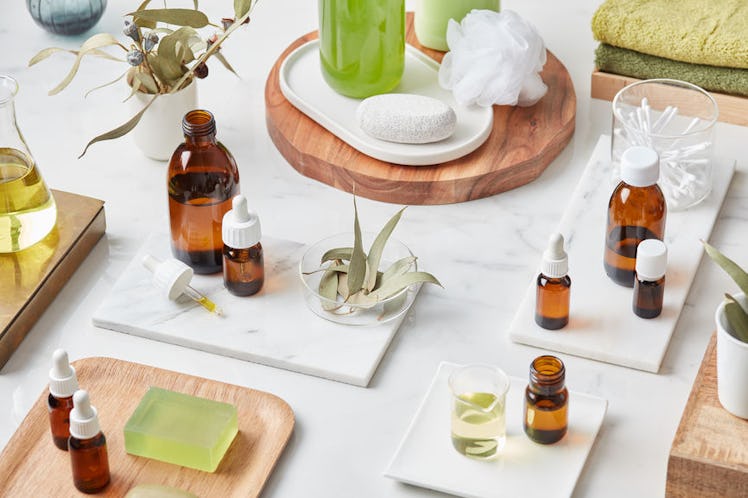
You've Heard The Buzz About Tea Tree Oil, But Here's Why You Shouldn't Put It Directly On Your Skin
Tea tree oil: It smells funny, has a weird name (what even is a tea tree?), and always reminds me of a middle-school lice outbreak. Tea tree oil has been used for hundreds of years to heal wounds, ward off lice, and treat acne, but many folks are actually using it the wrong way. There’s a proper method on how to use tea tree oil for your skin safely — one that’ll prevent you from possible irritation or worse, dermatitis.
If you look up “Australian Tea Tree” on Google, you’ll find gorgeous pictures of a tree type that features twisting, shredding branches; thin, green leaves; and white budding flowers. Tea tree oil is extracted from this magical tree, boasting anti-fungal, anti-inflammatory, and antibacterial benefits. “Tea tree oil has antimicrobial properties and may help lower levels of acne-causing bacteria on the skin, which, in turn, reduces inflammation to improve breakouts,” Joshua Zeichner, director of Cosmetic & Clinical Research in Dermatology at Mount Sinai Hospital in New York City, tells Elite Daily.
However, while tea tree oil can help in treating acne, it can also be irritating on the skin. “The big downside to tea tree oil is potential irritation,” says Dr. Zeichner. “If you’re going to use it, do so carefully and consider diluting it in a carrier oil like coconut oil.” Coconut oil is among the multiple “carrier oils” suggested when mixing essential oils with other oils before applying to your face. Since applying neat tea tree oil (i.e. without a carrier oil) can possibly cause dermatitis or other skin allergies, it’s advised to avoid applying it directly to your skin.
As Dr. Zeichner touched upon, the key is to mix about one to two drops of essential tea tree oil with three to four drops of another carrier oil, such as grapeseed oil, jojoba oil, or rosehip oil, and then apply it to your face or use it as a spot treatment. By diluting the essential oil, you’re significantly decreasing the chance of an allergic reaction or irritation, but still reaping the skincare benefits.
According to the American Academy of Dermatology, adult acne in women is on the rise, which might explain why more skincare brands are incorporating tea tree oil into their products. Biossance, a clean skincare company, focuses on plant-based squalane technology and just recently launched a new range of products featuring tea tree oil. The squalane in the Biossance Squalane + Tea Tree Balancing Oil ($49, sephora.com) acts as a carrier for the tea tree oil, helping to hydrate skin while treating acne simultaneously.
Nuria Beauty, another skincare brand focused on using clean, safe ingredients in its products, includes tea tree oil into its Rescue-Pore Minimizing Toner ($24, nuriabeauty.com), which helps to not only purify pores, but also prepares skin for serums or moisturizers used afterward. Since the tea tree oil is mixed in with multiple other ingredients in this toner, it’s safe to use topically without fear of a strong allergic reaction.
Lastly, InstaNatural’s Acne Cleanser ($18, amazon.com) incorporates tea tree oil into its acne-fighting cleanser. The 2 percent salicylic acid helps to diminish blemishes, while the vitamin E and aloe vera offer hydrating benefits, too.
Preventing dry, flaky skin after using tea tree oil on acne is key, so always make sure you’re incorporating a hydrating oil, emollient, or gel into the mix so that you can treat acne without overly irritating your skin.